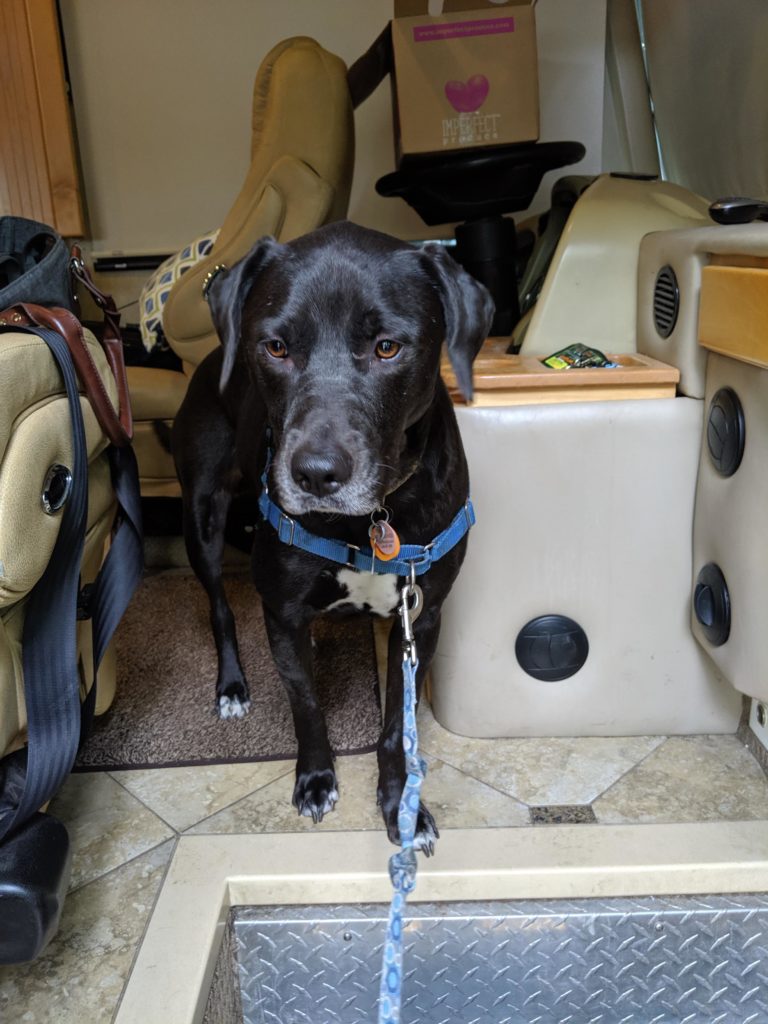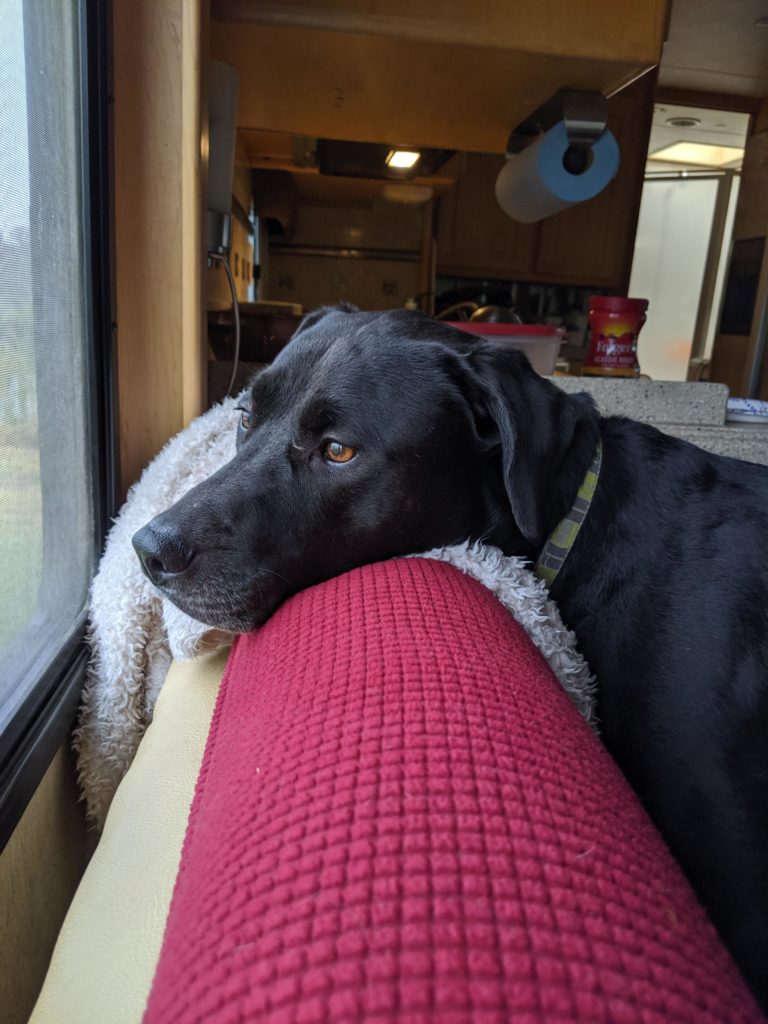Okay, are you joking me? We’ve been full-time RVers for nearly two years and I’ve never written a blog about how to RV with a dog? Well, better late than never! I’m going to throw out some of the tips and lessons we’ve learned while RVing with our dog. Those lessons will likely be at least a little different for you. Normally I like to open with a little story, but I have a bunch of doggy-related RV information that I am ready to blurt out on the page.
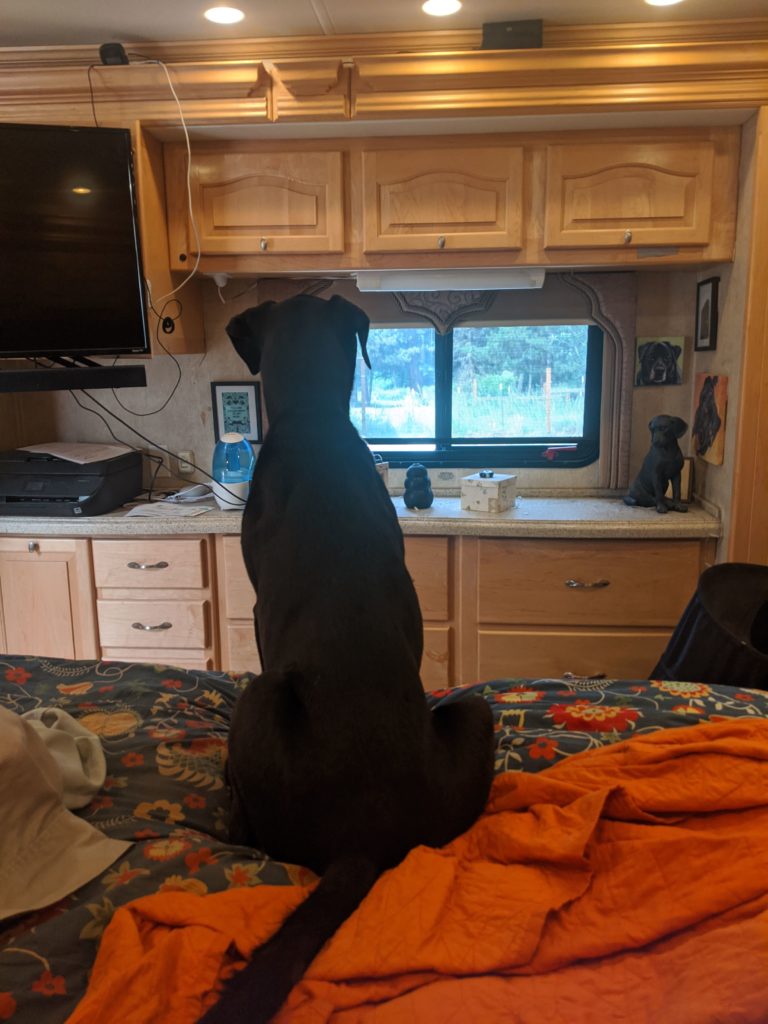
Can I leave my dog in an RV at a campground or RV park?
Yes! We leave Bernie at nearly every campground we go to. We never leave her on a travel day though. What that means is when we arrive at a campground, we don’t leave her in the RV alone in during that day. We’ve found she’s highly anxious and needing of extra walks the rest of that day, and we’re typically pretty zonky. (Zonky is the word I use for tired eyes, or how I feel when I take a Benadryl.) So, we will go on a walk, and then just chill out with her.
We’ve read some bloggers that won’t ever leave their dog in an unintended RV but we look at it as our home, and sometimes we simply don’t have the option to bring her everywhere.
Here are some tips we have about leaving your pupper in the camper while you go out and about.
- Just like a sticks-and-bricks house, make sure you let your pooch out before you go anywhere for a long period of time. During the era of COVID, we hardly ever leave Bernie for too long since we’re not really out dining and going to events as much. Places can be further away than you might think though – so check the traffic, and then count down the hours you expect to be away.
- Set a timer. We set a timer when we’re gone for more than about 5-6 hours so we know that we will be home to take our tuxed-clad daughter out by hour nine. While she can easily go longer, she’ll never urinate or poop in the home. I never want her to feel uncomfortable.
- Pills. Our little pet Bernadette takes pills every 8 hours. If we’re gone during that time, we use a timed feeder so when it pops open, she wanders over and noms up her little pill. We put some pungent treats in there to tempt her. (Neat treats are our favorite, but anything that’s smelly works.) Train your dog to take treats from a feeder before you need to leave her alone in the RV.
- We have a Blink camera that we use to spy on Bernie. Sometimes, I just feel like checking on her, so I grab my phone, hit the Blink app, and check to see how she’s doing. The camera was the cheapest one available when we purchased it, and it’s worked great for how we use it.
- A temperature monitor can be an anxiety reducer if you’re afraid your dog is too hot or too cold in the RV. Truthfully, we don’t have one, but we simply would never leave Bernie if there were any chance that her furry little body would overheat. With our camera, it also helps to reduce that anxiety – we can turn the sound on and notice if the A/C is running for instance.
- Bernadette suffered from extreme separation anxiety for a period of time – and with dogs, you need to address separation anxiety in the RV just as you would in an apartment, house, etc. If you have any questions on how we addressed that, please reach out! We are more than open with the work we’ve put into training Bernie and the fact that we have behaviorists who help her.
What dogs are best for RV living?
Your dog. I know, that seems silly, but you can train any dog to normalize to RV life. Training a puppy in an RV will have some advantages; they inherently know that RV life is “normal” life, but there’s nothing like tripping down a small pair of stairs to run a dog outside to pee in the middle of the night, and frankly, there are many RV parks were that’s not possible right outside the door. If you are looking to get a great travel dog, we’re big advocates of pitties and labs. Match your dog to your lifestyle though. If you’re not going to be going on daily runs, then a german shepherd, collie, or other high energy dog isn’t for you. Don’t want to be outsmarted? Well, then don’t get a dog like Bernadette, whatever she is.
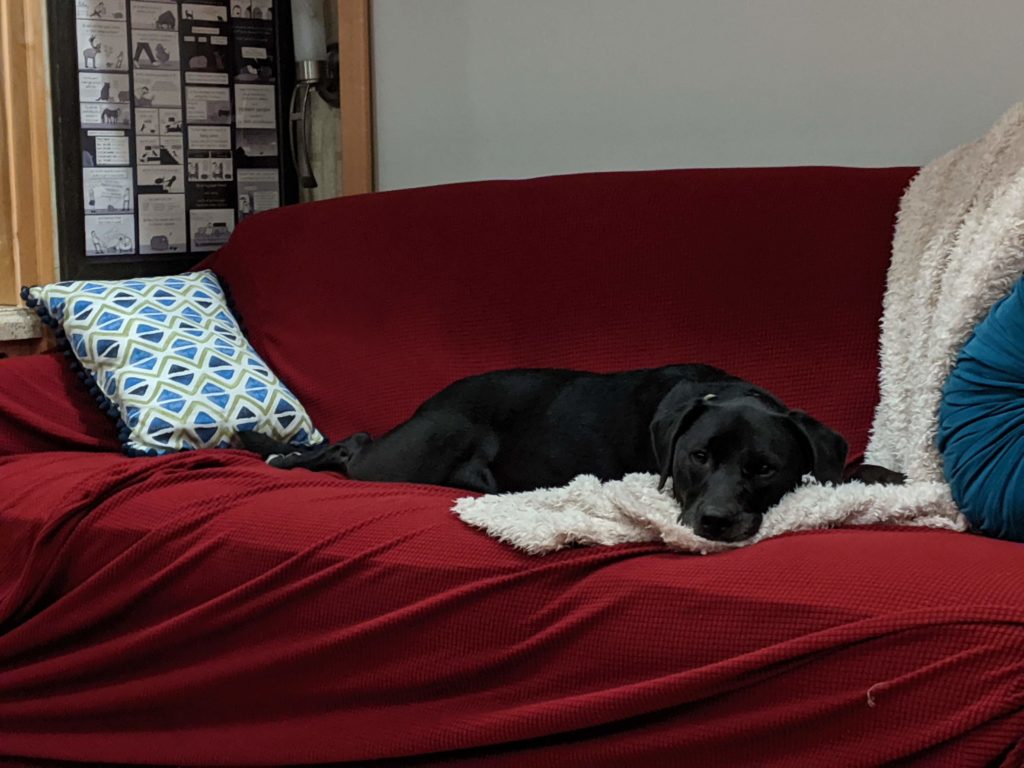
How do you keep a dog entertained in such a small space like an RV?
Treats are your best friend. Mental stimulation is a must – do behavior work on rainy days, and get your pup on sniffer walks!
On those rainy weeks when your pup can’t get as much walks as you might like, you can try use a dog puzzle – we have a couple of treat puzzles that Bernie likes to do when she needs some mental stimulation. We also make some out of boxes and do mini obstacle courses in the RV when we experience a lot of rain or less than ideal weather.

Can I travel with a pet crate?
We don’t use any pet enclosures, and we would never advise you to ever leave your dog chained up or in a fenced area right outside your RV without you. This just puts them and other dogs in harm’s way. An RV park is not your yard. Even on boondocking sites in the middle of nowhere, the longest we’d ever leave Bernie outside on a long lead without us would be about 2 minutes. Please be mindful that your dog might be friendly, there are plenty of creatures that aren’t. Keep your dog leashed at all campgrounds and RV parks and shared public land.
If your dog is crate trained, you may want to secure the dog in the crate during travel days until they get used to traveling. We chose not to do this for space issues, even though Bernie was crate trained. Crates take up a large amount of space, and it was either that or her coveted dog bed. Her bed won.

Are certain RVs better for dogs than others?
When we purchased our RV, we actually had two dogs: Gordon, and Bernadette. Gordon unexpectedly died right before we hit the road. We were so grateful we were able to leave the home where Gordon had died, but to be honest, we didn’t think about floor layout much when it came to our pups. Things we did consider:
- As little carpet as possible, because we knew we’d be in a lot of dirty places with a lot of dirty paws. We talked about if we purchased a motorhome with carpet fully removing it. And, you may think we’re a little nuts, we do have carpet in the bedroom…and it still has the plastic covering on it nearly two years after we purchased it. It’s easy to vacuum up dog hair. Carpet is notorious for capturing smells, and we want to avoid that as much as possible. (We are considering ripping up the little carpet we have left.)
- A space that is adequate for your dog, as well as particular spaces that your dog is keen towards. Furry Bernie prefers a den-like area to sleep and rest, particularly when we’re gone. We’ve placed a bed under our dining table when we’re not traveling, as well as a blanket underneath the edge of the bed that hangs over the floor. She seeks these areas out 75% of the time. She likes hiding, and we knew that and planned for it when we got the RV.
Does your dog like looking out windows? Make sure you have a pet-friendly area they can pop up and look out windows. Do they bark at anyone that walks by? Skip the floor to ceiling windows entirely. You know your dog best. Just think about those big issues before driving away in a motorhome or fifth wheel that will cause problems.
How should I introduce my sweet canine to RV life?
Just like anything with dogs, introduce your motorhome, fifth wheel, or camper slowly to your furry family member. Let the pooch recognize it’s there before even bringing them into the RV. We brought a favorite blanket into the RV before we ever brought our pooches in. Also, we’d spent three nights in it so it had started smelling like us already at that point. Don’t expect your best friend to automatically understand that this is their new home or vacation spot – take things slowly.
What should I do with my pup in the RV on travel days?
The first few travel days weren’t great with Bernie in our Class A motorhome. She licked thedoor trying to get out – and shivered often. So, we took a blanket that she thinks is “safe” and made a tent with my legs and the dashboard that she would then hide under. My legs got very tired. We knew it wasn’t sustainable. So, we started rewarding her whenever she’d come out to peek around. There were many days where I physically had to keep her from trying to dash under Jeremiah’s legs. If you’re towing a camper or fifth wheel, your dog won’t notice the difference of a travel day versus a regular ride in the car.
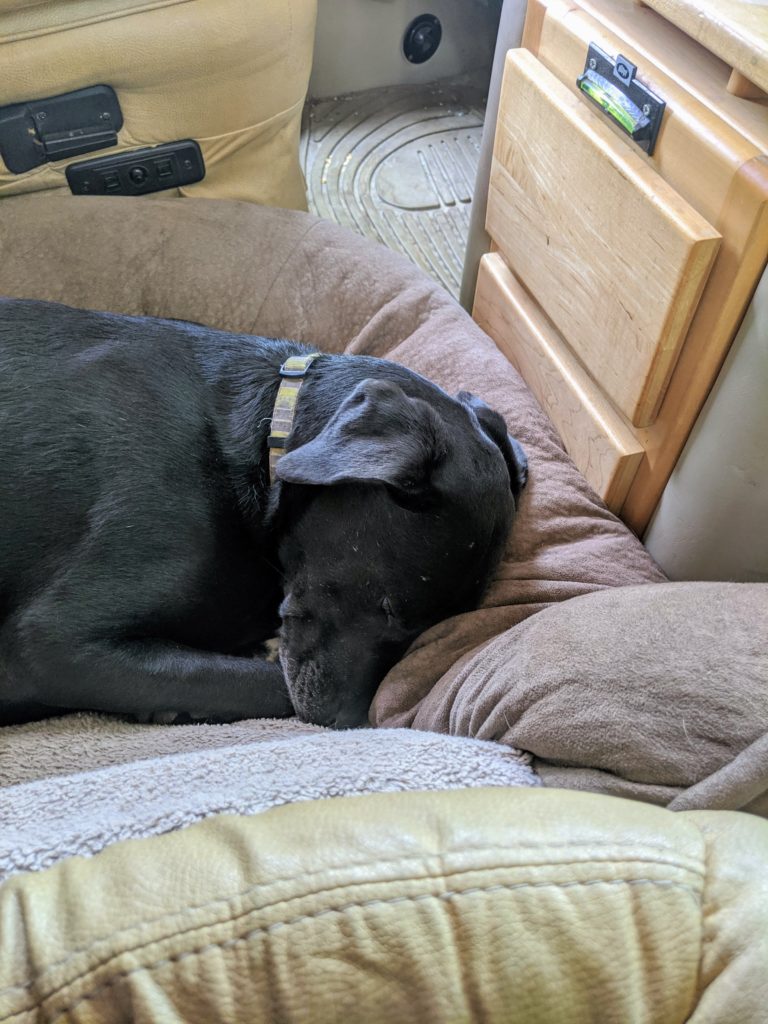
Now, as soon as we bring in the slides and hit the road, Bernadette lies down and goes to sleep. She is incredibly good as a traveler, but it took time. (About a month or two of consistent travel.) As I mentioned above, some choose to use a crate – we do not. If you’re traveling with a pet like a cat, I would advise putting them in a cat carrier. Felines tend to dart around more than puppers.
How do I deal with vet appointments and vaccines on the road?
We struggled with finding a vet on the road. Previously we’d used a local vet, so we sought out local vets the first year we were on the road. The biggest obstacle we faced was that there were always new pet fees and there was always a load of information we had to provide each time we got to a new vet. When we finally had absolutely awful service with horrible vet treatment in Texas, we decided to switch to Banfield. We’re never more than a couple hours away from a Banfield because they’re in many Pet stores. All of Bernie’s pet vaccines are up to date. The only issue we run into with them is simply explaining to them that we need her meds sent to a new location every time.
Pet behaviorists and dog prescriptions while traveling
Here is where our behaviorist comes in. If you’re lucky enough to have a pretty chill dog, you’ve likely never dealt with an animal behaviorist. We’ve used the same fantastic Portland-based dog behaviorist and trainers for several years. Now, we work with her online – which is awesome.
She prescribes our lovable pooch a year’s worth of prescription at a time that we can fill across the states. We’ve used Walmart, Walgreens, and CVS to fill her prescriptions. We’ve found they each have quirks. Wal-mart, as an example, does not keep the prescription information between stores, but they are quick to fill the prescription. Walgreens does not always have great communication. We discovered that CVS is overall the simplest to use. However, it also happens to be incredibly expensive compared to the other options. Take your pick. Make sure you plan a week in advance to have your prescriptions filled if you’re moving from one pharmacy to another. We’ve run out before due to miscommunications between our vet and the pharmacy, and it was bad. Just, bad.
If you only need things like tick medications and heart guard, have your vet fill them yearly. That way you don’t have to stress.
A note on vaccinations: have your vaccinations printed out. We keep them in our front drawer. Some state parks require printed vaccination proof, and if you want to cross the border from Mexico into the states, you need proof you’re not bringing a street dog into the states.
Are there some places I shouldn’t take my dog?
RV park places to avoid: Some RV parks have strict breed restrictions due to insurance requirements. We’ve been forced to not use some due to size issues. These are fairly rare. Check pet policies before you go somewhere.
National Parks: Sigh. Nearly every national park does not allow dogs on trails or anywhere other than paved areas. This is one of the reasons we don’t frequent many of them, but it’s also another reason we want to be comfortable leaving little doggo in the RV. Some places will have specific trails dogs can go on, so research before you go. Others have a “bark ranger” program which will show you dog-friendly options. Google the dog-friendly hikes before you get there.
Know before you go: wild areas: It’s easy to take for granted that you know the place you live, and the places your dog should avoid in that area. When you start RVing though, you’ll need to be aware of poisonous bugs, snakes, other wildlife, and thing like blue-green algae which can kill a dog quickly. Don’t ever let your dog swim or drink from a source of water that you are not sure about. Small dogs are good meals for alligators, so simply be aware of your surroundings. If in doubt, leave the pet in the RV or car.
What other tips about dog RV travel should I know?
-If your RV has maintenance issues, La Quinta and Red Roof Inn are very dog friendly if you need an overnight motel stay.

-Always pick up your dog’s poop. Keep the land you stay on cleaner than when you arrived. That means dog waste too. Just ‘cuz someone else didn’t doesn’t mean you shouldn’t.
-Some RV parks have dog parks that are great to take advantage of after a long travel day. KOA’s are spendy, but are great for having dog parks. Bernie can jump fences about 5 feet, so we keep an eye on her at these.
-This shouldn’t have to be said, but just in case it does, do not ever travel with your dog in a trailer or fifth wheel. They should be with you wherever you are traveling. A pet bouncing around in a trailer or fifth wheel down the road is absolutely a no-go and incredibly unsafe. Just do not do it. Please.
-Have a dog food that you can purchase from a big box store. We buy ours at Costco. We always have extra since we don’t know the next time we’ll be near one. If you have prescription dog food, ask your vet if you can purchase an extra bag ahead of time. This reduces the chance of running out if the mail delivery has a hiccup, etc. Traveling to Canada? Don’t overbuy the dog food. You may be required to toss it at the border.
-Buy a wall-hanging vacuum. Don’t expect that the vacuum that may come with your RV to do a thorough job. Dog hair gets everywhere, but it’s a lot easier to vacuum 300 square feet than 3,000.
Have we covered everything dog oriented when it comes to traveling in an RV? Probably not. What questions do you have that we can answer for you? Bernie wants to answer them all! Let us know in the comments the questions you have.


